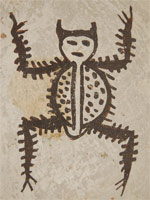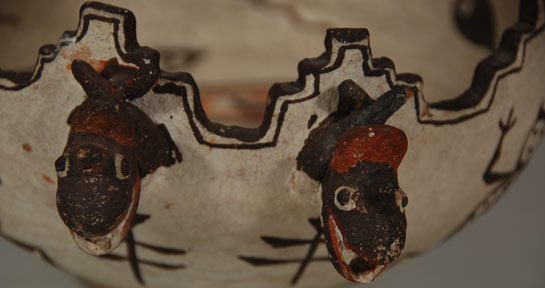Adobe Gallery Blog
Subject: Zuni Pueblo Bowl with Plumed Serpents in Sculpture Relief
Vessels such as this Zuni bowl suggest use in ceremonial functions but most likely that has not occurred. It is more likely that such were made solely to sell to tourists. Zuni elders would not have permitted ceremonial vessels to leave the pueblo and be sold.
An interesting story will illustrate the events that dealers would go to in order to sell pottery, and probably other Native items, in the early 1900s. Museums were eager to acquire ceremonial objects which, of course, were not generally available unless someone from the pueblo sold something without permission to do so.
Because of the desire by museums in the Santa Fe area, the trader at Zuni in the early 1900s seems to have dreamed up a scheme to "find" a cache of Zuni ceremonial pottery jars and sell them to the Laboratory of Anthropology in Santa Fe. Around 1920, a large group of Zuni ceremonial vessels supposedly were available from Zuni and the trader made a deal to sell them to the Lab. There were around 260 of them. The Lab director convinced John D. Rockefeller of New York, who had earlier funded the building for the Lab, to purchase this important and secret collection for a sum of around $10,000, which was a very large amount at the time when jars were selling for maybe $1 or slightly more.
 Because the transaction was a hushed-up affair, the cache of jars was stored in a vault at the Lab where they stayed for over 75 years. When Dr. Bruce Bernstein was director of the Museum of Indian Arts and Culture, he became interested in the collection and spent the next 20 years studying them and getting advice from Zuni elders who declared they were not ceremonial in any manner. This was a hoax that was clothed in secrecy and ultimately uncovered. The Zuni were probably innocent of the charade. Potters most likely received orders for ceremonial-like vessels and made them by the trader's specification and sold them without knowing they were being sold as historic.
Because the transaction was a hushed-up affair, the cache of jars was stored in a vault at the Lab where they stayed for over 75 years. When Dr. Bruce Bernstein was director of the Museum of Indian Arts and Culture, he became interested in the collection and spent the next 20 years studying them and getting advice from Zuni elders who declared they were not ceremonial in any manner. This was a hoax that was clothed in secrecy and ultimately uncovered. The Zuni were probably innocent of the charade. Potters most likely received orders for ceremonial-like vessels and made them by the trader's specification and sold them without knowing they were being sold as historic.
This Zuni bowl we are featuring today is not of the style of the ones at the Lab but is a style based on ceremonial vessels used by the Zuni, but, unless a vessel has been used in ceremonial fashion, it is not ceremonial even if it is of the same style. The use of water creatures-in this case frogs, dragonflies, tadpoles, and plumed serpents-is standard fare on ceremonial vessels, so this bowl could be labeled "pseudo-ceremonial" if one wished to do so. The plumed serpent is known as Kolowisi at Zuni and is an important water creature. Kolowisi is a hero to the Zuni because he saved them from a flood and provided sustenance to them at the time. After the flood, he stayed at the pueblo and resides underground in a lake. He can and does appear in irrigation acequias and the Zuni River or any other body of water and serves as a guardian of water sources.
This bowl has 7 terraces around the rim and a footed base, elements generally not used except on ceremonial bowls. On the exterior of the bowl are five frogs and two dragonflies painted in brown as is the rim of the bowl. On the interior are five tadpoles and a frog also painted in brown. The bodies of a pair of Kolowisi are raised on the clay body and painted in brown and red and outlined in brown. The heads of the serpents penetrate the bowl and hang on the exterior. Their heads are brown and the plumes are red.
The bowl evokes an element of mystique and makes one think it is an item used in a secret fashion in some ceremony in a kiva not witnessed by anyone other than high priests or important persons. It feeds that need in us to feel we have discovered something that is rare and wonderful, which, in reality, is true. These are rare and wonderful and one is fortunate to be able to add one to a collection.
Condition: original condition
Provenance: from a family in Santa Fe
Recommended Reading: The Pottery of Zuni Pueblo by Francis Harlow and Dwight Lanmon
Subject: Zuni Pueblo Bowl with Plumed Serpents in Sculpture Relief
Potter Unknown
Category: Historic
Origin: Zuni Pueblo
Medium: clay, pigments
Size: 5" deep x 9-1/2" diameter
Item # C3357


